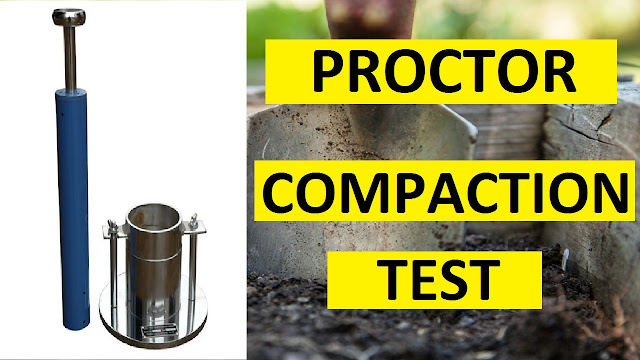PROCTOR COMPACTION TEST
The Proctor compaction test is a laboratory method of experimentally determining the optimal moisture content at which a given soil type will become most dense and achieve its maximum dry density. The test is named in honor of Ralph R. Proctor who in 1933 showed that the dry density of a soil for a given compactive effort depends on the amount of water the soil contains during soil compaction. His original test is most commonly referred to as the standard Proctor compaction test; his test was later updated to create the modified Proctor compaction test.
These laboratory tests generally consist of compacting soil at known moisture content into a cylindrical mold of standard dimensions using a compactive effort of controlled magnitude. The soil is usually compacted into the mold to a certain amount of equal layers, each receiving a number of blows from a standard weighted hammer at a specified height. This process is then repeated for various moisture contents and the dry densities are determined for each. The graphical relationship of the dry density to moisture content is then plotted to establish the compaction curve. The maximum dry density is finally obtained from the peak point of the compaction curve and its corresponding moisture content, also known as the optimal moisture content.
The testing described is generally consistent with the American Society for Testing and Materials (ASTM) standards, and are similar to the American Association of State Highway and Transportation Officials (AASHTO) standards. Currently, the procedures and equipment details for the standard Proctor compaction test is designated by ASTM D698 and AASHTO T99. Also, the modified Proctor compaction test is designated by ASTM D1557 and AASHTO T180-D.
OBJECT OF EXPERIMENT
The object of the experiment is to determine the compaction characteristics of given soil.
THEORY
The dry density γd is given by the following relation
γd = γ/1 + ω
where, γ = Bulk density of soil ; ω = Moisture content of soil
APPARATUS
1. Proctor’s standard equipment consisting of
(a) Proctor’s mould
(b) Hammer
2. Electric oven
3. Balance
4. 4.75 mm sieve
5. Steel spatula
PROCEDURE
1. About 2.5 kg of loose soil passing through 4.75 mm sieve, is taken.
2. The empty proctor mould is weighed in the platform balance.
3. The proctor mould is filled with the soil in three layers, each layer being compacted by 25 blows of the standard rammer of 2.6 kg dropped from a height of 31 cm above the soil. After compacting the second layer the mould is fitted with a detachable collar for compaction of third layer. The compacted layer is then finished to a level surface just at the rim of the mould itself.
4. The mould with this soil is weighed is the platform balance. The bulk density of the soil is calculated.
5. A small amount of the compacted soil is taken in a container of known weight for determination of moisture content.
6. The dry density is calculated from the bulk density and moisture content as obtained in steps 4 and 5 respectively.
7. Steps 3 to 6 are repeated with increasing moisture content of the soil.
8. Moisture content of soil is increased by adding water 2 – 5 % by weight of dry soil each time. Bulk density of contacted soil will increase initially with the increase in moisture content. After certain moisture content bulk density will decrease. The test is repeated till a decreasing trend in bulk density is observed.
9. From the data as obtained from the tests mentioned above moisture content vs. dry density curve is plotted for the soil. From the curve, optimum moisture content and maximum dry density are determined.
OBSERVATIONS AND RESULT
1. Details of the proctor mould :
(a) Height =
(b) Diameter =
(c) Volume =
(d) Weight =
2. Dry density and moisture content :
Observation No.
|
1
|
2
|
3
|
4
|
5
|
Weight of mould + compacted soil (kg)
|
|||||
Weight of compacted soil (kg)
|
|||||
Bulk Density (kg/cm3)
|
|||||
Can No.
|
|||||
Weight of empty can (W1) (gm)
|
|||||
Weight of can + wet soil (W2) (gm)
|
|||||
Weight of can + dry soil (W3) (gm)
|
|||||
Moisture content, ω (%) = {(W2 – W3)/(W3
– W1)} x 100
|
|||||
Dry Density, γd = γ/1 + ω
|
RESULT
Plot dry density vs moisture content.
From the curve, find optimum moisture content and maximum dry density.








Proctor compaction test video upload please
ReplyDeleteSir please tell me how is download the pdf about all of civil testing notes and other civil notes
ReplyDeleteAeronautical Engineering works in airplane, rockets and helicopters. Then again, Astronautical Engineering incorporates space transports, rockets and space stations. high voltage ceramic capacitor
ReplyDeleteWorking and creating gadgets and frameworks that utilization atomic radiation and energy for performing undertakings is the duty of atomic designers. These designers are required in a crowd of ventures, for example, space travel, military, medical services, energy and progressed research. diode
ReplyDelete